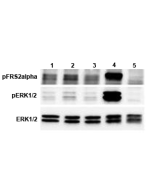Cookie Policy: This site uses cookies to improve your experience. You can find out more about our use of cookies in our Privacy Policy. By continuing to browse this site you agree to our use of cookies.
AdipoGen Life Sciences
FGF-21 (human) (rec.)

| Product Details | |
|---|---|
| Synonyms | Fibroblast Growth Factor 21 |
| Product Type | Protein |
| Properties | |
| Source/Host | HEK 293 cells |
| Sequence |
Human FGF-21 (aa 29-209) is fused at the C-terminus to a FLAG®-tag. |
| Crossreactivity | Human |
| MW | ~22kDa (SDS-PAGE) |
| Purity | ≥90% (SDS-PAGE) |
| Endotoxin Content | <0.01EU/μg purified protein (LAL test; Lonza). |
| Concentration |
After reconstitution: for 10µg size: 0.1mg/ml for 50µg size: 1 mg/ml |
| Reconstitution |
10µg size: Reconstitute with 100µl sterile water. 50µg size: Reconstitute with 50µl sterile water. |
| Accession Number | Q9NSA1 |
| Formulation | Lyophilized. Contains PBS. |
| Other Product Data |
UniProt link Q9NSA1: FGF21 (human) FLAG is a registered trademark of Sigma-Aldrich Co. |
| Shipping and Handling | |
| Shipping | BLUE ICE |
| Short Term Storage | +4°C |
| Long Term Storage | -20°C |
| Handling Advice |
After opening, prepare aliquots and store at -20°C. Avoid freeze/thaw cycles. Centrifuge lyophilized vial before opening and reconstitution. For maximum product recovery after thawing, centrifuge the vial before opening the cap. |
| Use/Stability |
Stable for at least 6 months after receipt when stored at -20°C. Working aliquots are stable for up to 3 months when stored at -20°C. |
| Documents | |
| MSDS |
 Download PDF Download PDF |
| Product Specification Sheet | |
| Datasheet |
 Download PDF Download PDF |
The fibroblast growth factor (FGF) family is a group of multifunctional signaling molecules that have a wide variety of functions. The family comprises of 22 related proteins, each grouped into subfamilies which are based on genetic and functional similarity. FGF21 is expressed in several tissues such as liver (main site), muscles, adipocytes, pancreas, and brain where it passes the blood-brain barrier. FGF-21 stimulates glucose uptake in differentiated adipocytes via the induction of glucose transporter SLC2A1/GLUT1 expression. Its activity requires the presence of the FGFR1 and β-klotho. FGF21 mediates the adaptive starvation response to induce ketogenesis, gluconeogenesis, lipolysis, and lipid β-oxidation. FGF21 plays also a key role in cardiac remodeling with the heart expressing fibroblast growth factor receptor 1 (FGFR1), β-klotho, as well as FGF21. In muscle, FGF21 expression in skeletal muscles is due to mitochondrial dysfunction and ER stress.







